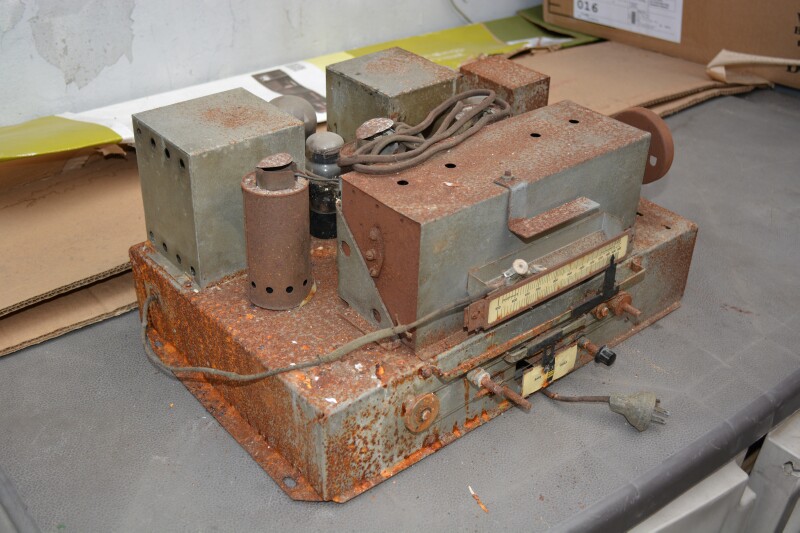01-17-2014, 03:27 AM
What should I use on this old Delco?
1) naval jelly
2) deruster
3) sandblaster
4) plastique

1) naval jelly
2) deruster
3) sandblaster
4) plastique
|
Question about old GM/Delco chassis
01-17-2014, 03:27 AM
What should I use on this old Delco?
1) naval jelly 2) deruster 3) sandblaster 4) plastique
01-17-2014, 09:52 AM
This Delco?
Brenda, I (and all of us here) know you can work wonders, so you have nothing to prove, unless maybe to yourself. Now toss that to the recycling bin. A recycling truck is a good tool to use.
01-17-2014, 10:44 AM
My vote is for plastique
. Eric The Villages, FL Member: Philco Phorum, ARF, ARCI & Radiomuseum.org
01-17-2014, 11:04 AM
If you find a remote area with no bystanders or law enforcement...like a shooting range.....my vote is for it too!
Could be spectacular. We can call it: "FLYING DELCO CIRCUS!!!" ONLY HERE ONLY TODAY!!! RUSH TO SEE!!! And you can charge admission. Which could be used to buy a, say, less rusty Delco.
01-17-2014, 11:05 AM
Yep, C4.
Chuck Chuck Schwark, The Philco Repair Bench [Image: http://www.philcorepairbench.com/images/philog3tiny.gif] http://www.philcorepairbench.com
01-18-2014, 01:17 AM
I'd media blast it with one of the micro blasters they use to frost glass. Sort of like an airbrush for media.
John Las Vegas, NV USA
01-18-2014, 01:38 AM
You can call me crazy but I have seen much worse. That chassis looks like most of the rust is a light to medium scale, if it was really bad it would have thick, dark scabs all over it. Step number #1 is to take lots of pictures and diagrams and start taking it apart. If you can get a hold of some Evapo Rust or a reasonable facsimile, you should be able to dunk the parts in it, minus coils and transformers, apparently it does not effect copper, aluminum or brass so you could leave the sockets in place. If you can't find Evapo Rust (or facsimile) you can also try a mixture of water and molasses, both work by chealation and are NOT acidic.
You could also try electrolysis for stripping rust, but you would have to remove any copper, aluminum, or brass parts from the chassis and other bits first. Well you may get away with the copper and brass but not the aluminum. That will get it down to bare metal, it will even take paint off if there is any. But two things you need are a low voltage high current power supply, that puts out a clean DC current, If you use a battery charger you will need to add a filter cap to the output. You will also need a sacrificial anode with a large surface area. For an electrolyte you can use baking soda, washing soda, or trisodium phosphate, about a cups worth in a gallon or more of water. Negative side of supply connects to the part you are stripping, positive goes to the sacrificial anode. Regards Arran
05-13-2014, 09:37 AM
WEeeeelllll...
I started playing with this chassis yesterday. First off I used a wire brush to take off the rust that I could get to. There's still some around the dial and between the transformers that I'll have to get a different brush for, but overall the rust came off very easily. It was almost all surface rust. After tracking down the two main issues (audio choke and B+ line) I've now been able to receive several strong stations with my outside antenna. Have to replace all the caps, which is going to be a PITA, but I'll manage. I'm just amazed that I'm getting anything at all through the beast.
05-13-2014, 09:59 AM
Brenda
Set that radio somewhere and put a big sign over it "Undead". Just be careful that it does not start going 'round the house saying "brains.....brains" and then trying to suck out the electrolytes from other radio's caps.
05-13-2014, 10:11 PM
I just can't stand to see a piece of vintage tube gear that is not working. I have several chassis that will never be in a cabinet, but I just HAD to bring them back to life. Maybe I have the (Ms.) Frankenstein syndrome?
05-13-2014, 11:16 PM
Brenda,
This is the second advanced stage of hoarding: first you collect junk, then you start making it work.
05-14-2014, 01:51 AM
Mike, I'm a crazy cat lady, too.
05-14-2014, 08:50 AM
Which means it is under a dozen or so? That ain't crazy.....40+ is crazy. Unless of course you could afford to pet every single one, know their names, and still could afford the vet bills. Of, and stand all the meowing...especially in March.
05-14-2014, 04:24 PM
All but one of ours are fixed. No going into heat. The last one is going in later this week. (We just got him a few weeks ago.)
« Next Oldest | Next Newest »
Users browsing this thread: 1 Guest(s) |
|

|